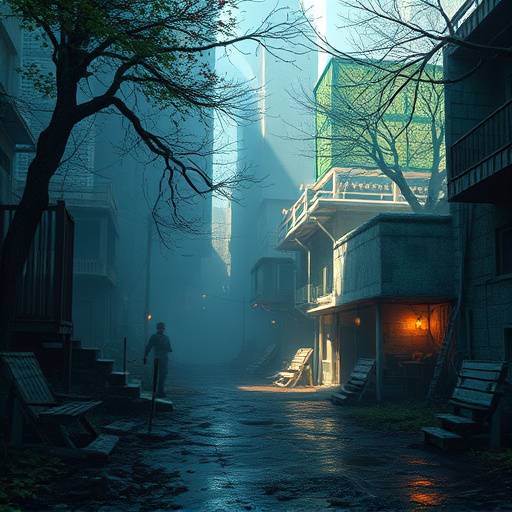A New Era of Digital Artistry
Video games have transcended their early days as pixelated diversions to become a dominant force in visual culture. The way games look directly influences how we play, feel, and connect with virtual worlds. This evolution is not merely about technological advancement; it's a sophisticated interplay of artistic vision, narrative intent, and player psychology. From the abstract elegance of early interfaces to the hyper-detailed environments that blur the lines between simulation and reality, the visual language of games is a constantly evolving canvas. This site delves into the core of this transformation, examining the defining styles and the forces that shape them.
Our journey begins with an understanding of how visual design impacts player immersion and the overall experience. The choices made by game developers in color palettes, character design, environmental storytelling, and user interface elements all contribute to a unique digital tapestry. As hardware capabilities have expanded, so too has the ambition of artists and designers to create worlds that are not only playable but also aesthetically profound. This evolution mirrors broader trends in art and design, reflecting societal shifts and technological innovations. We will trace this path, highlighting the milestones and the maestros who have painted these interactive masterpieces.

Minimalism: Clarity and Focus
Discover how sparse design principles create powerful and intuitive gameplay experiences, prioritizing essential information and elegant aesthetics.
Explore Minimalist GamesEmotional Realism: Depth and Impact
Witness the power of hyper-detailed graphics and lifelike character models to evoke deep emotional responses and unparalleled immersion.
Explore Realistic Games
The Human Element
Delve into the art of character design and animation that allows players to connect on a deeply emotional level with virtual protagonists and antagonists.
See Character ArtThe Dichotomy of Style: From Austerity to Abundance
The visual landscape of gaming is often characterized by a fascinating dichotomy, a constant negotiation between restraint and excess. On one end, we have the philosophy of minimalism, which champions clarity, focus, and the power of suggestion. This approach strips away the superfluous, presenting players with interfaces and environments that are immediately understandable and aesthetically clean. It leverages negative space, subtle animations, and a carefully curated color palette to guide attention and enhance the core gameplay mechanics. Games that embrace minimalism often aim for a timeless elegance and a profound sense of calm, allowing the player's imagination to fill in the blanks.
Conversely, the pursuit of emotional realism seeks to overwhelm the senses with detail, fidelity, and a commitment to verisimilitude. This style aims to create worlds so convincing, so rich with texture and light, that they feel tangible. Characters are rendered with lifelike imperfections, environments teem with intricate details, and animations capture the nuances of human (or non-human) movement and expression. The goal here is to achieve a visceral connection, to make the player forget they are interacting with a screen and instead feel truly present within the game's universe. This often involves pushing the boundaries of graphical technology and sophisticated art direction.

Minimalism in game design is not about emptiness; it's about intentionality. Think of the elegant UI of Monument Valley , where each button and icon serves a clear purpose and contributes to the overall serene atmosphere. Or consider the stark, geometric landscapes of FEZ , where simplicity in form allows for profound puzzle mechanics and a sense of wonder. This design philosophy often prioritizes the player's cognitive load, ensuring that information is presented in a digestible and non-intrusive manner. It’s about finding beauty in restraint and allowing the player to focus on the essence of the experience. The absence of visual clutter can paradoxically lead to a richer, more engaging interaction, as players are encouraged to interpret and engage with the world on a deeper, more intuitive level. This style is particularly effective in puzzle games, narrative-driven experiences, and titles that aim for a contemplative mood.
The ambition for realism is evident in titles like The Last of Us Part II or Red Dead Redemption 2 . These games strive for a photorealistic rendering of their worlds, complete with dynamic weather systems, intricate environmental details, and character models that convey a wide spectrum of emotions through subtle facial animations. This commitment to detail serves a crucial narrative function: to ground players in believable scenarios and foster empathy with characters facing extraordinary circumstances. The visual fidelity allows for a more profound exploration of complex themes and human experiences, making the virtual world feel as rich and nuanced as our own. Developers meticulously craft every leaf on a tree, every ripple on water, and every strain of emotion on a character's face to create an immersive tapestry that captivates the player's senses and emotional core. This dedication to visual fidelity is a testament to the power of games as a storytelling medium.
"The best visuals in games don't just look good; they feel right. They serve the gameplay and the story, enhancing immersion without becoming a distraction."
The Art of Understatement: The Appeal of Minimalism
Minimalism in video games is more than just a visual style; it's a design philosophy rooted in clarity, efficiency, and elegance. It’s about stripping away the extraneous to reveal the essential, creating experiences that are both intuitive and aesthetically refined. This approach often relies on a limited color palette, clean geometric shapes, and an emphasis on negative space to guide the player's attention and simplify complex interactions. The aim is to create a sense of calm and focus, allowing players to engage deeply with the core mechanics and narrative without being overwhelmed by visual noise.
Consider the impact of a minimalist UI. Instead of cluttered menus and overwhelming icons, players are presented with a streamlined interface where essential information is readily accessible. This can significantly reduce the learning curve and make games more approachable, even for those new to the medium. For instance, games like Journey masterfully employ minimalist design to convey emotion and narrative through subtle visual cues and environmental storytelling, allowing players to project their own feelings onto the sparse yet evocative world. The player's interaction feels organic, directly tied to the simplified visual language. This focus on essence allows for a powerful emotional resonance, often achieved through mood and atmosphere rather than explicit detail.
The elegance of minimalism extends to environmental design as well. Rather than filling every corner with intricate detail, minimalist games often use carefully placed elements to create a sense of scale, mood, and purpose. A single, striking object or a vast expanse of emptiness can be more impactful than a densely packed scene. This approach encourages introspection and allows players to appreciate the artistic intent behind each carefully chosen element. It's a testament to the idea that less can indeed be more, fostering a unique type of visual appreciation where the player's engagement is amplified by the deliberate absence of clutter. The resulting aesthetic is often timeless, avoiding the visual trends that can quickly date more detailed styles.

Abstract Worlds
Explore games that use abstract shapes and limited palettes to create unique visual experiences and focus on core mechanics.
Discover Abstract Games
Intuitive Puzzles
See how minimalist design enhances the clarity and satisfaction of puzzle-solving mechanics.
View Puzzle ExamplesThe Fidelity of Feeling: Embracing Emotional Realism
Emotional realism represents a zenith in the visual arts, where the goal is not just to depict a world, but to make players *feel* it. This stylistic movement pushes the boundaries of what's visually possible, utilizing cutting-edge graphics technology, sophisticated animation techniques, and meticulous attention to detail to create experiences that resonate deeply on an emotional level. It’s about crafting characters with believable expressions, environments that breathe with life, and narratives that are amplified by their visual fidelity.
The power of emotional realism lies in its ability to foster empathy. When characters' faces are rendered with subtle cues of joy, sorrow, anger, or fear, players can connect with them on a profound level. This is achieved through advanced techniques like subsurface scattering for skin rendering, complex facial rigging, and motion capture that captures the nuances of human performance. Games like Hellblade: Senua's Sacrifice stand as prime examples, using photorealistic visuals and sound design to immerse players in the protagonist's journey through psychosis, creating an unforgettable and deeply affecting experience. The visual storytelling here is paramount, directly contributing to the game's thematic weight and emotional impact.
Environments in emotionally realistic games are not just backdrops; they are characters in themselves. Developers meticulously craft every detail, from the way light filters through a dense forest canopy to the wear and tear on urban streets, to evoke specific moods and enhance the narrative. The weather systems can dynamically shift, influencing both the visual spectacle and the player's emotional state, making the virtual world feel dynamic and alive. This level of detail ensures that players are not just observers but participants in worlds that feel authentic and full of emergent possibility. The result is a powerful sense of immersion where the player feels truly transported into the game's narrative and world. This dedication to visual verisimilitude is crucial for players seeking escapism and deeply engaging storytelling.
Characters That Live
Examine how advanced character models and animation bring virtual beings to life with compelling emotional depth.
Explore Character Art
Worlds That Breathe
Discover how meticulously crafted environments contribute to immersion and storytelling.
See Environmental ExamplesThe Horizon: Future Visual Trends
The relentless march of technology and artistic innovation promises an even more dazzling future for visual culture in gaming. We are on the cusp of breakthroughs that will further blur the lines between the real and the digital, offering players experiences that are more immersive, interactive, and emotionally resonant than ever before.
Consider the impact of advanced AI-driven procedural generation, which could lead to infinitely varied and dynamic worlds that adapt to player actions in real-time. Ray tracing and advanced lighting techniques will continue to evolve, creating environments with unprecedented realism in how light interacts with surfaces. Furthermore, the integration of virtual and augmented reality technologies is poised to redefine immersion, offering ways to interact with game worlds that are deeply personal and physically engaging. The future of gaming visuals is not just about looking better; it's about feeling more, connecting more, and experiencing more.
The collaborative efforts between artists, engineers, and designers will continue to push the envelope, exploring new forms of interactivity and visual expression. As hardware becomes more powerful and software tools more sophisticated, the creative possibilities for game developers will expand exponentially. We can anticipate experiences that are not only visually stunning but also deeply meaningful, using the unique power of interactive media to explore complex themes and evoke profound emotional responses. The evolution is ongoing, promising a future where the visual canvas of gaming is limitless.
Stay tuned as we explore the cutting edge of these advancements in our Technologies section.